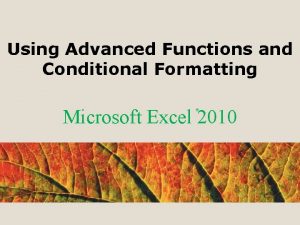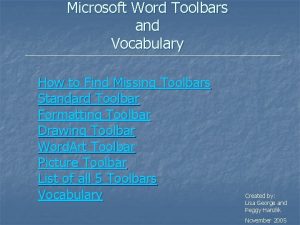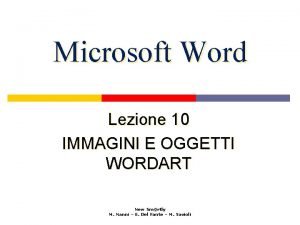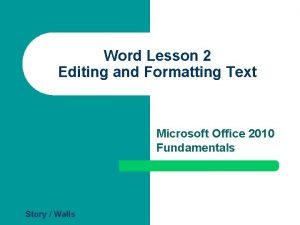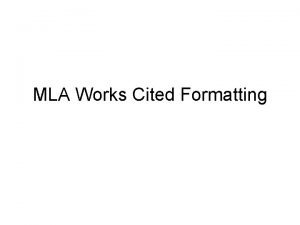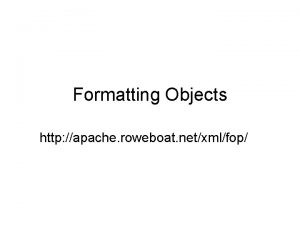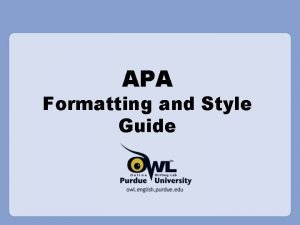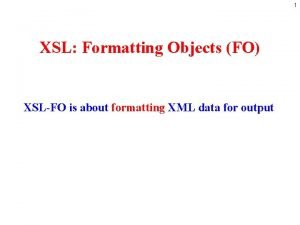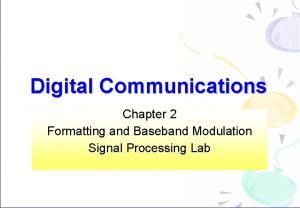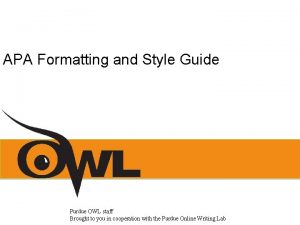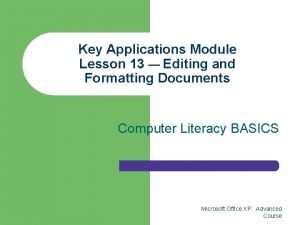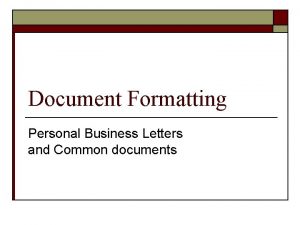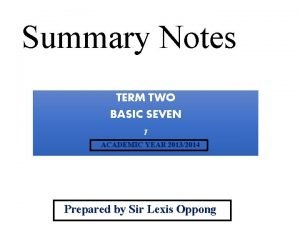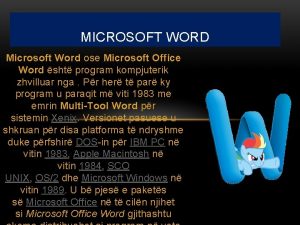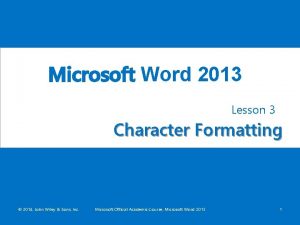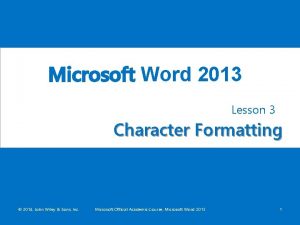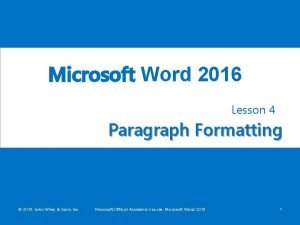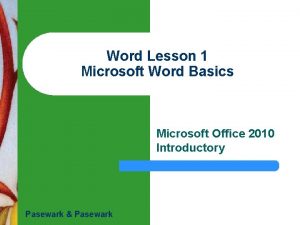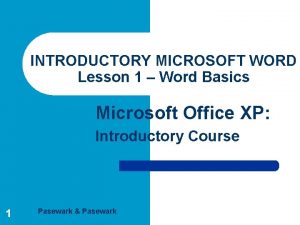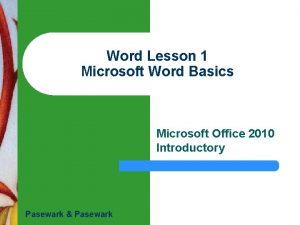Microsoft Word 2016 Lesson 3 Character Formatting 2016

































- Slides: 33

Microsoft Word 2016 Lesson 3 Character Formatting © 2016, John Wiley & Sons, Inc. Microsoft Official Academic Course, Microsoft Word 2016 1

Objectives © 2016, John Wiley & Sons, Inc. Microsoft Official Academic Course, Microsoft Word 2016 2

Software Orientation • As you learn to format text, it is important to become familiar with the Font group of commands. The Font group, see below, is displayed on the Home tab of the Ribbon. © 2016, John Wiley & Sons, Inc. Microsoft Official Academic Course, Microsoft Word 2016 3

Changing Fonts and Font Sizes • The default font for Word is Calibri. • Microsoft Word has a variety of fonts, font sizes, and attributes to help you communicate your intended message in a document. • Font sizes are measured in points. • Point sizes in Word range from the very small 8 -point size to 72 points or higher. © 2016, John Wiley & Sons, Inc. Microsoft Official Academic Course, Microsoft Word 2016 4

Changing Fonts and Font Sizes • The Font group in the Home tab contains drop-down menus for changing both typeface and font size. • Selecting text enables you to access the same commands using the Mini toolbar or by right-clicking to display a context menu, which provides access to the Font dialog box. • To change typeface or size using any of these tools, you first must select the text. • Another way to change the size of text is to select the text and click the Increase Font Size button to increase the font size or the Decrease Font Size button to decrease the size. © 2016, John Wiley & Sons, Inc. Microsoft Official Academic Course, Microsoft Word 2016 5

Step by Step: Change Fonts and Font Sizes 1. Open a document and select the first line. 2. In the Font group of the Home tab, click the Font drop-down arrow to display the Font menu (see right). 3. Scroll down the list and select another font. Notice as you point to each font in the list, the selected text changes with a live preview of what it would look like in that font. © 2016, John Wiley & Sons, Inc. Microsoft Official Academic Course, Microsoft Word 2016 6

Step by Step: Change Fonts and Font Sizes 4. With the text still selected, click the drop-down arrow on the Font Size menu. The menu appears (see right). Click a new size. 5. Point to the selected text to display the Mini toolbar. 6. Click the drop-down arrow on the Font menu on the Mini toolbar and choose a font. 7. Click the Increase Font Size button several times to increase the size of the text. © 2016, John Wiley & Sons, Inc. Microsoft Official Academic Course, Microsoft Word 2016 7

Applying Character Attributes • You can change the appearance of characters to apply emphasis to text. • Access the Font group on the Home tab to apply bold, italic, underline, and more attributes. • To open the Font dialog box, use one of the keyboard shortcuts or right-click to access a shortcut menu. • Click the Font command group dialog box launcher to open the Font dialog box for more options. • Text Effects add a distinctive appearance to selected text, such as outline, shadow, glow, and reflection. • To add Text Effects to selected text, click the drop-down arrow on the Text Effects button and then select from the available options on the menu or use the Font dialog box. © 2016, John Wiley & Sons, Inc. Microsoft Official Academic Course, Microsoft Word 2016 8

Step by Step: Apply Character Attributes 1. Select the title of a document. 2. In the Font command group, click the Bold, Italics, and Underline buttons to see how the text changes. 3. With the text still selected, click the drop-down arrow beside the Underline button to see a menu of underlining choices. 4. Hover each option to see how the selected text will appear. 5. With the text still selected, in the Font group, click the dialog box launcher. The Font dialog box appears. 6. In the Effects section, select the All Caps check box. Review the Preview area and notice how the text is now in all caps. © 2016, John Wiley & Sons, Inc. Microsoft Official Academic Course, Microsoft Word 2016 9

Step by Step: Apply Character Attributes 7. Click the drop-down arrow on the Font Color menu. A menu of colors appears. 8. A Screen. Tip appears when you place your insertion point over the colors. Pick a color and click OK. 9. With the text still selected, click the Text Effects dropdown arrow in the Font group. 10. Hover each of the options and then select an option, shown on the right. © 2016, John Wiley & Sons, Inc. Microsoft Official Academic Course, Microsoft Word 2016 10

Step by Step: Apply Character Attributes 11. With the title text still selected, right-click and then select Font. Click the Text Effects button to open the Format Text Effects dialog box. 12. Click the Expand button by the Text Fill command. 13. Select the an option and then click the drop-down arrow by the Preset gradients and select an option. 14. Click the drop-down arrow to change the Direction of the text. 15. Click OK to close the Format Text Effects dialog box and then click OK to close the Font dialog box. © 2016, John Wiley & Sons, Inc. Microsoft Official Academic Course, Microsoft Word 2016 11

Setting Character Spacing Character spacing refers to the spacing in and around each character of text. Character spacing options in Word include the following: • Scale: This setting makes each individual character wider or narrower and is described by a percentage, with 100% being normal. Height of the characters is not affected. • Spacing: This setting moves characters closer to or farther apart from each other. It does not change the size or shape of the letters. Choose Expanded or Condensed. • Position: This setting raises or lowers characters in relation to the baseline. It is similar to using subscript and superscript formatting, except that it does not make the affected characters smaller. © 2016, John Wiley & Sons, Inc. Microsoft Official Academic Course, Microsoft Word 2016 12

Step by Step: Set Character Spacing 1. Select text. 2. On the Home tab, click the dialog box launcher in the Font group. The Font dialog box opens. 3. Click the Advanced tab. 4. Open the Scale drop-down list and click 90%. 5. Open the Spacing drop-down list and click Expanded. Leave the By amount set to the default of 1 pt. 6. Click OK. © 2016, John Wiley & Sons, Inc. Microsoft Official Academic Course, Microsoft Word 2016 13

Using Format Painter • Format Painter is located in the Clipboard group on the Home tab. • You use it to copy attributes and other formatting from one block of text and apply them to other selected text within the document. • When you activate Format Painter, the mouse pointer becomes a paintbrush. • Clicking once on the Format Painter button enables you to copy and apply the format once; double-clicking allows you to apply the copied format to as many locations as you want. © 2016, John Wiley & Sons, Inc. Microsoft Official Academic Course, Microsoft Word 2016 14

Step by Step: Use Format Painter 1. Select a heading in your document. 2. On the Home tab, in the Clipboard group, click the Format Painter button once. The pointer changes to a paintbrush icon when you point to text. 3. Use the paintbrush pointer to select another heading. The copied format is applied and Format Painter is turned off. 4. Select a heading and then double-click the Format Painter button. 5. Select some text. The copied format is applied. 6. Select some more text. The copied format is applied again. © 2016, John Wiley & Sons, Inc. Microsoft Official Academic Course, Microsoft Word 2016 15

Formatting Text with Styles • Word provides predefined styles formatting documents instantly with a number of character and paragraph attributes. • You can modify existing styles, or create new styles. • The Styles pane lists the same styles displayed in the Styles gallery. • There are two types of styles: paragraph styles and character styles. • Paragraph style: The format is applied instantly to all text in the paragraph where the insertion point is, whether or not that text is selected. • Character styles are applied to individual characters or words that you select. Character styles have a lowercase letter a beside them. © 2016, John Wiley & Sons, Inc. Microsoft Official Academic Course, Microsoft Word 2016 16

Step by Step: Apply a Style 1. Use multi-selection to select all the headings and then click Heading 1 style is applied to all headings. 2. Select some regular text. In the Styles group, click the dialog box launcher. The Styles pane appears (see right). 3. Experiment with the selected text and apply different styles. Deselect the text and close the Styles pane. 4. Open the Navigation Pane. Practice browsing through the document using the Headings tab. Close the Navigation Pane. © 2016, John Wiley & Sons, Inc. Microsoft Official Academic Course, Microsoft Word 2016 17

Modifying Styles • Make modifications to an existing style using the Modify Style dialog box. • Place changes to styles in the current document, or new documents based on a template. • To change an existing style, right-click the style’s name in the Style gallery or the Style pane and then click Modify. The Modify Style dialog box appears. © 2016, John Wiley & Sons, Inc. Microsoft Official Academic Course, Microsoft Word 2016 18

Modifying Styles • Apply character attributes to a style by clicking on the Bold button, the Italics button, and the Underline button. • Click the drop-down arrow for Font and Font Size to adjust both of these settings. • Choose to Add to the Styles gallery. • Select the option to save the style Only in this document for the current document. • Select the option for New documents based on this template to ensure that the same style is applied. © 2016, John Wiley & Sons, Inc. Microsoft Official Academic Course, Microsoft Word 2016 19

Creating a New Style • Instead of using the built-in style, you might choose to create a brand-new style with a name that you choose. This is similar to modifying an existing style—all the same formatting options apply and the dialog boxes are virtually identical. • You can define a new style using a dialog box as you did in the preceding exercise, or you can select already-formatted text to use as an example. • For ease of applying a style, you can assign a keyboard shortcut to it. If you choose a key combination that is already assigned to some other action, the new assignment overrides the previous one. © 2016, John Wiley & Sons, Inc. Microsoft Official Academic Course, Microsoft Word 2016 20

Step by Step: Create a New Character Style 1. Select the text. 2. On the Home tab, click the Increase Font Size button once to increase the font size for the selected text. 3. On the Home tab, click the dialog box launcher in the Styles group. The Styles pane opens. 4. At the bottom of the pane, click the New Style button. The Create New Style from Formatting dialog box opens. 5. Open the Style type drop-down list and click Character. 6. In the Name box, type a new name. 7. Click the Format button. A menu appears. © 2016, John Wiley & Sons, Inc. Microsoft Official Academic Course, Microsoft Word 2016 21

Step by Step: Create a New Character Style 8. On the menu, click Shortcut key. The Customize Keyboard dialog box appears (see right). 9. Click in the Press new shortcut key text box and then press Ctrl+Alt+Shift+K. 10. From the Save changes in dropdown list, choose the current document. 11. Click Assign, click Close, and then click OK. 12. Apply the new style to some text. 13. Close the Styles pane. © 2016, John Wiley & Sons, Inc. Microsoft Official Academic Course, Microsoft Word 2016 22

Step by Step: Copying Styles Between Documents and Templates To copy a style, you use the Style Organizer. It enables you to view a list of the styles in two different documents or templates and then copy them from one location to another. 1. Open a document. 2. Save the file as a Word Template. 3. Close the file. 4. In the Classes document’s window, on the Home tab, click the dialog box launcher in the Styles group. 5. At the bottom of the Styles pane, click the Manage Styles button. © 2016, John Wiley & Sons, Inc. Microsoft Official Academic Course, Microsoft Word 2016 23

Step by Step: Copying Styles Between Documents and Templates 6. In the bottom left corner of the dialog box, click the Import/Export button. The Organizer dialog box appears. 7. Click the Close File button under the Normal template’s file list. The button changes to Open File. © 2016, John Wiley & Sons, Inc. Microsoft Official Academic Course, Microsoft Word 2016 24

Step by Step: Copying Styles Between Documents and Templates 8. Browse to the location containing the template you just saved. Select the file and then click Open. 9. Click a style on the left side and then click the Copy > button. The style appears in the templates list. 10. Click Close. A dialog box appears, asking if you want to save your changes. 11. Click Save. 12. Press the Close button in the upper right-hand corner of the Styles pane to close the Styles pane. © 2016, John Wiley & Sons, Inc. Microsoft Official Academic Course, Microsoft Word 2016 25

Creating and Modifying Word. Art • Word. Art is a feature that creates decorative effects with text. • Word. Art in Word 2016 has vibrant colors and shapes and a gallery of text styles. • As you begin working with Word. Art, the Drawing Tools Format tab appears and enables you to format the Word. Art by adding special effects. © 2016, John Wiley & Sons, Inc. Microsoft Official Academic Course, Microsoft Word 2016 26

Step by Step: Create and Modify Word. Art 1. Select text. 2. Click the Insert tab and, in the Text group, click the Word. Art button to display the menu as shown here. © 2016, John Wiley & Sons, Inc. Microsoft Official Academic Course, Microsoft Word 2016 27

Step by Step: Create and Modify Word. Art 3. Hover the options and choose one you like. The text is reformatted. The Word. Art and the Drawing Tools Format tab appears. 4. A text box appears around the Word. Art. Select the text box and change the font size to on the Home tab. 5. Place your insertion point along the text box outline until it changes to the move command—four arrows. Press the left mouse button to select the box and then drag the box to the horizontal center of the page. As you resize or move a text box, the text that surrounds the box automatically moves. 6. Select the text again. In the Word. Art Styles group on the Drawing Tools tab, select the drop-down arrow by the Text Outline button and select No Outline. © 2016, John Wiley & Sons, Inc. Microsoft Official Academic Course, Microsoft Word 2016 28

Step by Step: Create and Modify Word. Art 7. Click the Text Fill drop-down arrow and select a color. 8. Select Text Effects and then click Transform to display the menu shown to the right. 9. Hover the options under the Warp section—see how your text changes with live preview. Select an option. 10. CLOSE the file. © 2016, John Wiley & Sons, Inc. Microsoft Official Academic Course, Microsoft Word 2016 29

Step by Step: Insert Text from a File 1. Word provides the ability to insert text from an outside file into an open document. 2. Open a document. 3. Scroll down to the bottom of the document and place the insertion point after the final word. 4. Press Ctrl+Enter to insert a page break and move the insertion point to the next page. 5. On the Insert tab, in the Text group, select the Object dropdown list and click Text from File. The Insert File combo box appears, which looks almost exactly like the Open combo box. 6. Locate and select the another Word file. A new page of text appears in the document. © 2016, John Wiley & Sons, Inc. Microsoft Official Academic Course, Microsoft Word 2016 30

Formatting Existing Documents in Other File Formats Word 2016 can edit, format, and save a PDF document. You can also open, edit, and save documents that were saved in another type of file format, such as RTF and TXT. 1. From within Word, open a PDF. A prompt appears stating, “Word will now convert your PDF to an editable Word document. ” Click OK. 2. Select the whole document by pressing Ctrl+A and then change the Font. 3. Select some text to format with various bold, italics, and colors. 4. Save As a PDF file and change the filename. The new document opens in a new window. Notice the file contains the updated formatting changes. © 2016, John Wiley & Sons, Inc. Microsoft Official Academic Course, Microsoft Word 2016 31

Using the Clear Formatting Button Clearing unwanted formatting is easy using Word’s Clear Formatting button, which is located in the Font group and the Styles gallery. 1. Open a document. 2. Select some text. In the Font group, click Clear Formatting. The formatting is removed and the text returns to the default font, Calibri. 3. Press and hold Ctrl and select more formatted text and then click the Clear Formatting button in the Font group. (By holding the Ctrl key, you can use multi-selection to select noncontiguous text. ) Deselect all text. © 2016, John Wiley & Sons, Inc. Microsoft Official Academic Course, Microsoft Word 2016 32

Skill Summary © 2016, John Wiley & Sons, Inc. Microsoft Official Academic Course, Microsoft Word 2016 33
 Microsoft official academic course microsoft word 2016
Microsoft official academic course microsoft word 2016 Microsoft official academic course microsoft word 2016
Microsoft official academic course microsoft word 2016 What is an unqualified structured reference in excel
What is an unqualified structured reference in excel Microsoft official academic course microsoft excel 2016
Microsoft official academic course microsoft excel 2016 Which microsoft word tab contains the print command? *
Which microsoft word tab contains the print command? * Formatting toolbar in ms word
Formatting toolbar in ms word Word art microsoft word
Word art microsoft word Arrow font
Arrow font Title in apa format
Title in apa format Mla formatting works cited
Mla formatting works cited Modified style letter
Modified style letter Apache fop
Apache fop Abstract page apa
Abstract page apa Weather in excel
Weather in excel Xsl-fo
Xsl-fo How to show internal thoughts in writing
How to show internal thoughts in writing Gambar toolbar formatting
Gambar toolbar formatting Optical disk
Optical disk Gambar toolbar formatting
Gambar toolbar formatting Sqlplus format output
Sqlplus format output Formatting quotations and dialogue
Formatting quotations and dialogue Formatting in digital communication
Formatting in digital communication Sqlplus report formatting
Sqlplus report formatting Purdue owl apa citation
Purdue owl apa citation Pascal writeln formatting
Pascal writeln formatting Text box formatting
Text box formatting Smallest typable character
Smallest typable character Paragraph formatting
Paragraph formatting Enhancing a presentation with multimedia
Enhancing a presentation with multimedia Paragraph formatting
Paragraph formatting Personal business letter format
Personal business letter format Font name
Font name Pascal writeln formatting
Pascal writeln formatting A named group of formatting characteristics
A named group of formatting characteristics


